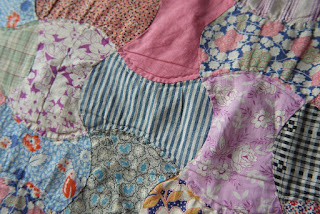 |
| Photo of old quilt by Julia_S at https://pixabay.com/photos/quilt-fabric-blanket-patchwork-4798469/ |
U.S. History Week 9
Transformation in the North, 1800-1850
I designed a quiz related to chapter 9 at the bottom of this article.
Directions for the quiz:
- Scroll down & click on the first thumbnail to enlarge to full screen.
- Choose an answer for each question.
- Click on the graphic to advance to the next screen.
- The correct answer is on the screen following the question.
- Compare your answers with those provided.
- If you cannot easily see the correct answer, check the captions.
An interactive version is available on Kahoot!
Search for this week’s topic by Katrena to find it.
Review the following Chapter 9 pages:
- Introduction
- Early Industrialization in the Northeast
- A Vibrant Capitalist Republic
- On the Move: The Transportation Revolution
- A New Social Order: Class Divisions
- Key Terms
- Summary
Practice learning Chapter 9 Key Terms on Quizlet.
Week 9 Videos:
- History Channel: Story of US Steamboats (3:07)
- Boston Manufacturing Company (8:14)
- Panic of 1819 (3:27)
- Erie Canal Song (2:20)
- 174 year old McCormick Reaper Demo (0:30)
- John Deere/Cyris McCormick (1:37)
- Invention of the Telegraph (1:30)
- Last Morse Code Maritime Station (4:49)
- PT Barnum’s 10 Most Famous Human Attractions (10:24)
Review the following information featuring the U.S.:
- Indiana (7:48)
- Franklin Pierce (1:28)
- Franklin Pierce: Moments of Grace
- Jane M. Pierce and Varina Davis: An Unlikely Friendship
Additional Resources:
Thanks for visiting my Student Survive 2 Thrive blog!
Find additional resources through my site map, topics tabs, or search bar.
Here are some of my articles you may find helpful this week:
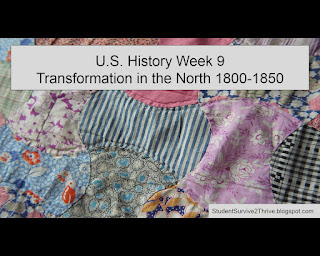 |
| U.S. History Week 9 Transformation in the North 1800-1850 |
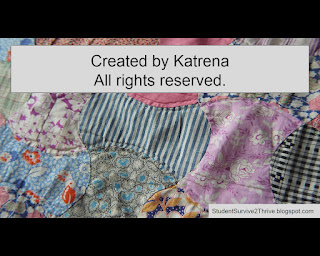 |
| Created by Katrena All rights reserved. |
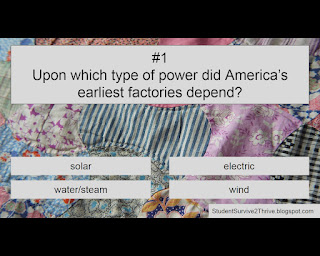 |
| Upon which type of power did America’s earliest factories depend? Answer choices include: solar, electric, water/steam, wind |
 |
| The correct answer is water/steam. |
 |
| The correct answer is: Earliest workers were primarily New England farm families. |
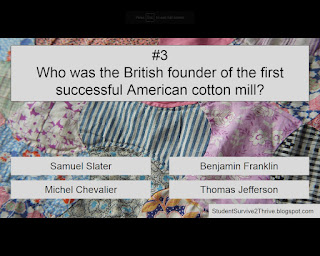 |
| Who was the British founder of the first successful American cotton mill? Answer choices include: Samuel Slater, Benjamin Franklin, Michel Chevalier, Thomas Jefferson |
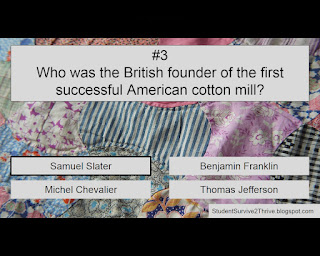 |
| The correct answer is Samuel Slater. |
 |
| The correct answer is labor theory of value. |
 |
| The Land Law of 1796 allowed people to purchase land from the government for $___ per acre. Answer choices include: 2, 5, 10, 50 |
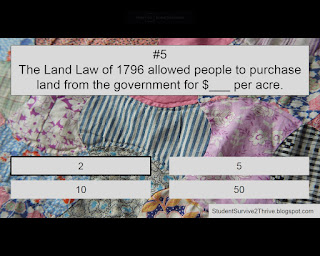 |
| The correct answer is 2. |
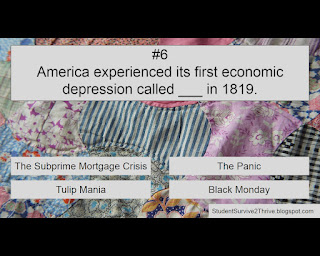 |
| America experienced its first economic depression called ___ in 1819. Answer choices include: The Subprime Mortgage Crisis, The Panic, Tulip Mania, Black Monday |
 |
| The correct answer is The Panic. |
 |
| Who invented/patented the cotton gin that could extract seeds more efficiently than doing so by hand? Answer choices include: Richard Arkwright, Moses Brown, Samuel Slater, Eli Whitney |
 |
| The correct answer is Eli Whitney. |
 |
| The Clermont, Fulton’s first ___ in 1807, greatly increased development along the Mississippi River Valley. Answer choices include: steamship, mechanical tractor, threshing machine, car |
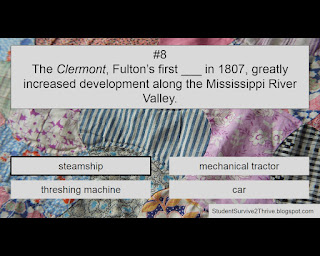 |
| The correct answer is steamship. |
 |
| What American created the telegraph? Answer choices include: Alexander Graham Bell, Samuel Morse, Wilson Bentley, John Deere |
 |
| The correct answer is Samuel Morse. |
 |
| A national highway connecting Maryland to Illinois called ____ was begun in 1811. Answer choices include: Cumberland Road, Route 66, Blue Star Turnpike, Blue Ridge Parkway |
 |
| The correct answer is Cumberland Road. |
 |
| The ___ connected the Hudson River with the Great Lakes and Mississippi River Valley. Answer choices include: Champlain Canal, Cape Cod Canal, Panama Canal, Erie Canal |
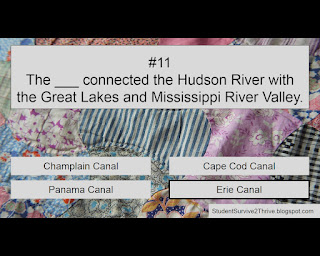 |
| The correct answer is Erie Canal. |
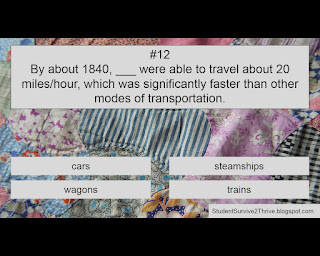 |
| By about 1840, ___ were able to travel about 20 miles/hour, which was significantly faster than other modes of transportation. Answer choices include: cars, steamships, wagons, trains |
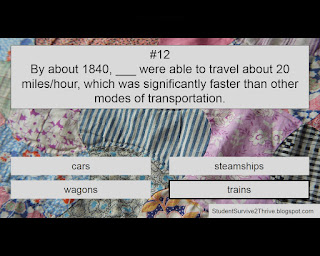 |
| The correct answer is trains. |
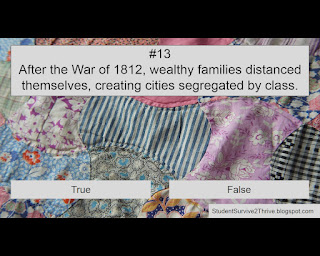 |
| After the War of 1812, wealthy families distanced themselves, creating cities segregated by class. Answer choices include: true, false |
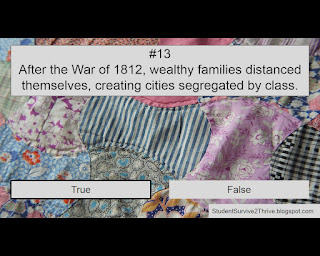 |
| The correct answer is true. |
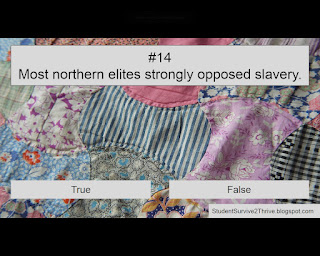 |
| Most northern elites strongly opposed slavery. Answer choices include: true, false |
 |
| The correct answer is false. |
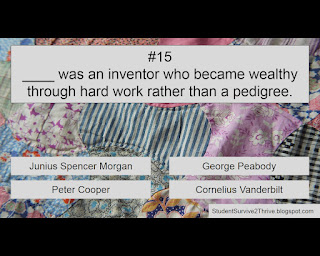 |
| ____ was an inventor who became wealthy through hard work rather than a pedigree. Answer choices include: Junius Spencer Morgan, George Peabody, Peter Cooper, Cornelius Vanderbilt |
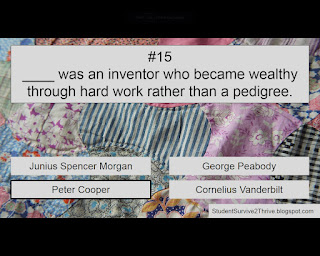 |
| The correct answer is Peter Cooper. |
 |
| Most American middle class children did the following EXCEPT: Answer choices include: attend school, play an instrument or read, play with skill-based toys or games, work in factories |
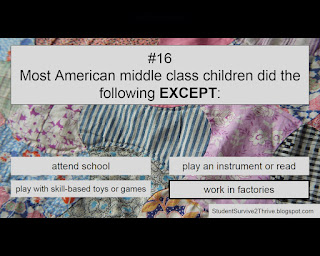 |
| The correct answer is work in factories. |
 |
| Middle-class women did not typically work for wages. Answer choices include: true, false |
 |
| The correct answer is true. |
 |
| The middle class generally encouraged abstinence from alcohol. Answer choices include: true, false |
 |
| The correct answer is true. |
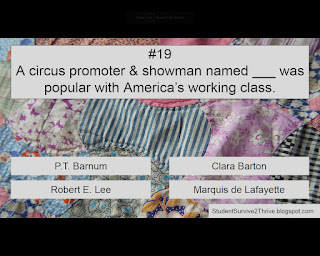 |
| A circus promoter & showman named ___ was popular with America’s working class. Answer choices include: P.T. Barnum, Clara Barton, Robert E. Lee, Marquis de Lafayette |
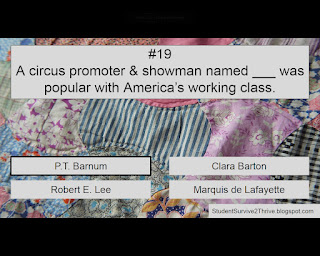 |
| The correct answer is P.T. Barnum. |
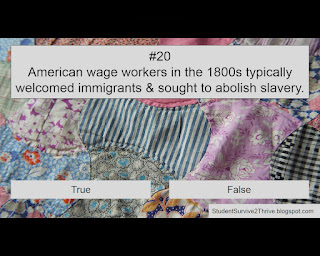 |
| American wage workers in the 1800s typically welcomed immigrants & sought to abolish slavery. Answer choices include: true, false |
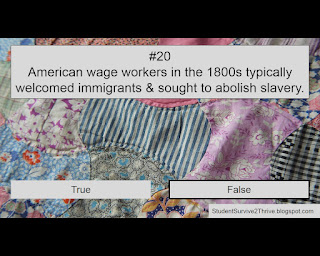 |
| The correct answer is false. |
 |
| Find more resources at StudentSurvive2Thrive.blogspot.com |


No comments:
Post a Comment
Thanks for reading my article and sending your comment! Please note that I do not place links to other web sites on this blog.
Note: Only a member of this blog may post a comment.